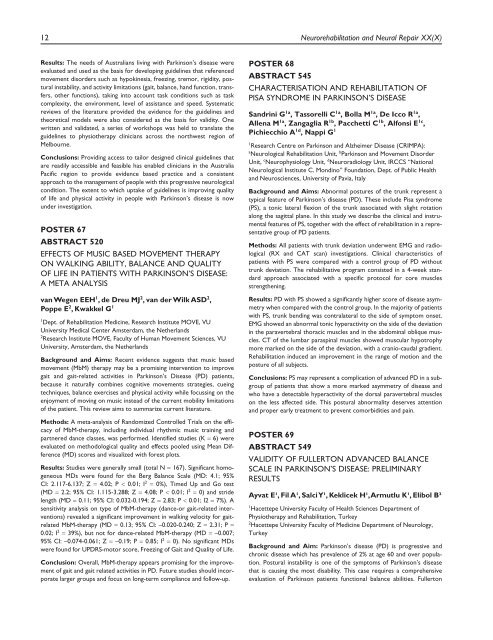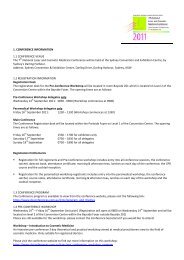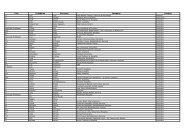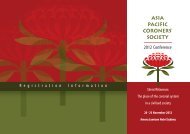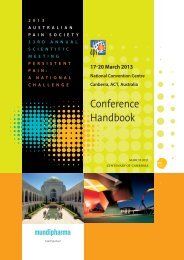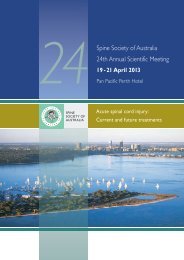WCNR 2012 Poster Abstracts - DC Conferences
WCNR 2012 Poster Abstracts - DC Conferences
WCNR 2012 Poster Abstracts - DC Conferences
Create successful ePaper yourself
Turn your PDF publications into a flip-book with our unique Google optimized e-Paper software.
12 Neurorehabilitation and Neural Repair XX(X)Results: The needs of Australians living with Parkinson’s disease wereevaluated and used as the basis for developing guidelines that referencedmovement disorders such as hypokinesia, freezing, tremor, rigidity, posturalinstability, and activity limitations (gait, balance, hand function, transfers,other functions), taking into account task conditions such as taskcomplexity, the environment, level of assistance and speed. Systematicreviews of the literature provided the evidence for the guidelines andtheoretical models were also considered as the basis for validity. Onewritten and validated, a series of workshops was held to translate theguidelines to physiotherapy clinicians across the northwest region ofMelbourne.Conclusions: Providing access to tailor designed clinical guidelines thatare readily accessible and feasible has enabled clinicians in the AustraliaPacific region to provide evidence based practice and a consistentapproach to the management of people with this progressive neurologicalcondition. The extent to which uptake of guidelines is improving qualityof life and physical activity in people with Parkinson’s disease is nowunder investigation.POSTER 67ABSTRACT 520EFFECTS OF MUSIC BASED MOVEMENT THERAPYON WALKING ABILITY, BALANCE AND QUALITYOF LIFE IN PATIENTS WITH PARKINSON’S DISEASE:A META ANALYSISvan Wegen EEH 1 , de Dreu MJ 2 , van der Wilk ASD 2 ,Poppe E 2 , Kwakkel G 11 Dept. of Rehabilitation Medicine, Research Institute MOVE, VUUniversity Medical Center Amsterdam, the Netherlands2 Research Institute MOVE, Faculty of Human Movement Sciences, VUUniversity, Amsterdam, the NetherlandsBackground and Aims: Recent evidence suggests that music basedmovement (MbM) therapy may be a promising intervention to improvegait and gait-related activities in Parkinson’s Disease (PD) patients,because it naturally combines cognitive movements strategies, cueingtechniques, balance exercises and physical activity while focussing on theenjoyment of moving on music instead of the current mobility limitationsof the patient. This review aims to summarize current literature.Methods: A meta-analysis of Randomized Controlled Trials on the efficacyof MbM-therapy, including individual rhythmic music training andpartnered dance classes, was performed. Identified studies (K 6) wereevaluated on methodological quality and effects pooled using Mean Difference(MD) scores and visualized with forest plots.Results: Studies were generally small (total N 167). Significant homogeneousMDs were found for the Berg Balance Scale (MD: 4.1; 95%CI: 2.117-6.137; Z 4.02; P 0.01; I 2 0%), Timed Up and Go test(MD 2.2; 95% CI: 1.115-3.288; Z 4.08; P 0.01; I 2 0) and stridelength (MD 0.11; 95% CI: 0.032-0.194; Z 2.83; P 0.01; I2 7%). Asensitivity analysis on type of MbM-therapy (dance-or gait-related interventions)revealed a significant improvement in walking velocity for gaitrelatedMbM-therapy (MD 0.13; 95% CI: –0.020-0.240; Z 2.31; P 0.02; I 2 39%), but not for dance-related MbM-therapy (MD –0.007;95% CI: –0.074-0.061; Z –0.19; P 0.85; I 2 0). No significant MDswere found for UPDRS-motor score, Freezing of Gait and Quality of Life.Conclusion: Overall, MbM-therapy appears promising for the improvementof gait and gait related activities in PD. Future studies should incorporatelarger groups and focus on long-term compliance and follow-up.POSTER 68ABSTRACT 545CHARACTERISATION AND REHABILITATION OFPISA SYNDROME IN PARKINSON’S DISEASESandrini G 1a , Tassorelli C 1a , Bolla M 1a , De Icco R 1a ,Allena M 1a , Zangaglia R 1b , Pacchetti C 1b , Alfonsi E 1c ,Pichiecchio A 1d , Nappi G 11 Research Centre on Parkinson and Alzheimer Disease (CRIMPA):a Neurological Rehabilitation Unit, b Parkinson and Movement DisorderUnit, c Neurophysiology Unit, d Neuroradiology Unit, IRCCS “NationalNeurological Institute C. Mondino” Foundation, Dept. of Public Healthand Neurosciences, University of Pavia, ItalyBackground and Aims: Abnormal postures of the trunk represent atypical feature of Parkinson’s disease (PD). These include Pisa syndrome(PS), a tonic lateral flexion of the trunk associated with slight rotationalong the sagittal plane. In this study we describe the clinical and instrumentalfeatures of PS, together with the effect of rehabilitation in a representativegroup of PD patients.Methods: All patients with trunk deviation underwent EMG and radiological(RX and CAT scan) investigations. Clinical characteristics ofpatients with PS were compared with a control group of PD withouttrunk deviation. The rehabilitative program consisted in a 4-week standardapproach associated with a specific protocol for core musclesstrengthening.Results: PD with PS showed a significantly higher score of disease asymmetrywhen compared with the control group. In the majority of patientswith PS, trunk bending was contralateral to the side of symptom onset.EMG showed an abnormal tonic hyperactivity on the side of the deviationin the paravertebral thoracic muscles and in the abdominal oblique muscles.CT of the lumbar paraspinal muscles showed muscular hypotrophymore marked on the side of the deviation, with a cranio-caudal gradient.Rehabilitation induced an improvement in the range of motion and theposture of all subjects.Conclusions: PS may represent a complication of advanced PD in a subgroupof patients that show a more marked asymmetry of disease andwho have a detectable hyperactivity of the dorsal paravertebral muscleson the less affected side. This postural abnormality deserves attentionand proper early treatment to prevent comorbidities and pain.POSTER 69ABSTRACT 549VALIDITY OF FULLERTON ADVANCED BALANCESCALE IN PARKINSON’S DISEASE: PRELIMINARYRESULTSAyvat E¹, Fil A¹, Salci Y¹, Keklicek H¹, Armutlu K¹, Elibol B²1 Hacettepe University Faculty of Health Sciences Department ofPhysiotherapy and Rehabilitation, Turkey2 Hacettepe University Faculty of Medicine Department of Neurology,TurkeyBackground and Aim: Parkinson’s disease (PD) is progressive andchronic disease which has prevalence of 2% at age 60 and over population.Postural instability is one of the symptoms of Parkinson’s diseasethat is causing the most disability. This case requires a comprehensiveevaluation of Parkinson patients functional balance abilities. Fullerton


